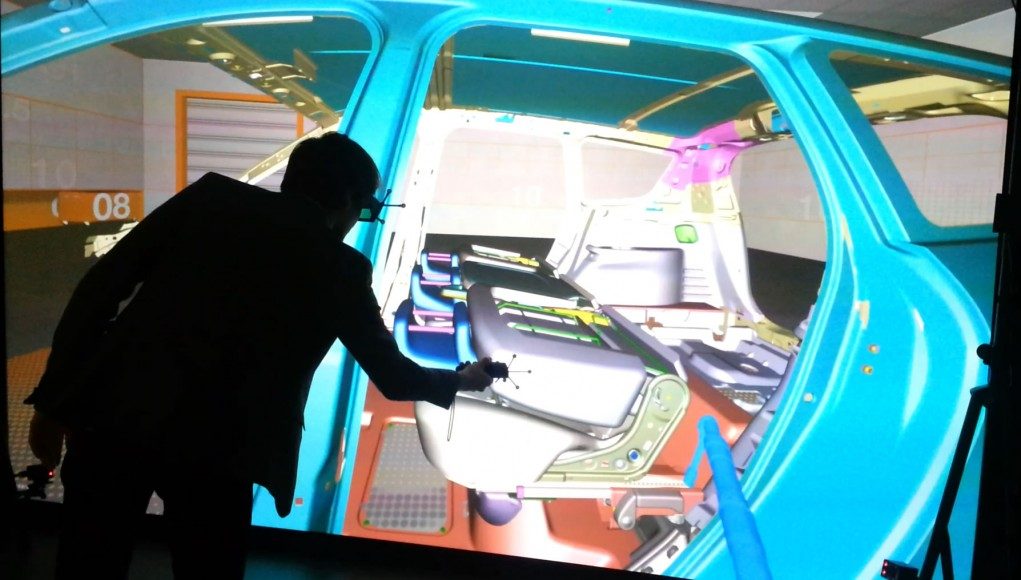Dominic Brennan gets his hands on ESI Group’s latest iteration of IC.IDO, their automotive visualisation tool that uses CAD-accurate data to generate extremely realistic VR simulations which let you take apart (or fix) your own virtual car.
The GPU Technology Conference in Amsterdam drew much interest from the automotive sector, with a focus on autonomous driving, AI and visualisation. ESI Group’s IC.IDO program is an established virtual reality software solution with a long history in automotive and other manufacturing industries, through the use of CAVE systems, Powerwalls and 3D displays. For many years, it has been the leading software for workflow testing and decision making in a VR environment, with customers such as Bombardier, Ford and MAN.
In the VR Village, ESI Group were showcasing their upcoming Version 11 of IC.IDO, which enables HMD support (it was running on the HTC Vive, but will support the Oculus Rift too). While the beta version had been unveiled at ESI’s North American VR Summit a couple of weeks before GTC Europe, this was the first time it was being shown to the wider press.
The demo was presented as a “Virtual Service” scenario for a vehicle, which involved mounting the “Brake Booster” in an offline assembly operation, and raising the car on a hoist to access the exhaust pipe. According to Eric Kam, Product Marketing and Community Manager at ESI Group, this was a simplified demo, which would typically involve more accessibility and serviceability checks with engineers, technicians and designers present to validate the process. “What makes IC.IDO special is that we enable engineers to work with CAD data with little or no pre-processing of CAD into new or reduced formats.” The software is powerful, modelling multi solid body mechanics and the elastic behaviour of wires and hoses.
With everything set to real-life scale, picking up a virtual tool with a Vive controller, stepping under the car, loosening some bolts and removing part of the exhaust felt natural and most importantly, it was clear that each piece was interacting with other pieces with accurate collision detection. “Often time during service it would be desired to remove components without having to take all subsystems apart – modelling real-time interactions of the various parts is essential,” says Eric. “Most CAD mock up tools will not live simulate the collisions possible during assembly”.
One aspect of virtual testing that differs from reality is the mass of the components involved. The brake booster I clumsily fitted in VR is certainly not as a light as a Vive controller in real life for instance. IC.IDO has a few solutions to offer, depending on the application, according to Eric. “We often use our ergonomics plugin to enable useful feedback. These types of analysis allow the “pantomime” of VR to evaluate what would happen to humans if they followed those same actions under load. It indicates whether supporting a heavy virtual object under a given posture would stress the body in a bad way.” Using tracked objects with realistic mass, like the actual tools or assembly components is something that they’ve done in the past with CAVEs, but less practical for a VR headset. “Some mix between VR and AR would be needed”, says Eric.
But the benefits of HMDs over CAVEs is pretty clear – for one it is far more cost-effective, and can be set up more easily and used more frequently. Achieving the actions in the demo of getting underneath a car on a hoist would require ceiling projection, which not all CAVE systems have. Ultimately, the HMD is a simpler solution and “key to democratising the engineering benefit”, according to Eric. “The reduced cost means that now engineering decisions that are often “batched” into larger reviews can be made more frequently and earlier. CAVEs are very powerful collaboration tools that are often used by executives and managers of engineering groups to make key gate reviews. Because these reviews are made infrequently, that means that intermediate decisions are often made without the benefit of VR. HMDs might mean that two rank-and-file engineers at different locations could potentially collaborate immersively to make a better design decision without waiting until the CAVE is free.”
Version 11 of IC.IDO rolls out in November. HMD support will be an add-on for the existing desktop version of the software. “We believe that with version 11.0 our customers will be more effective in being able to review immersively that which could not be experienced without a CAVE”, says Eric. “More frequent and earlier application of VR will mean that engineering designs will be more mature and more cost effective.”
Disclosure: Nvidia paid for accommodation for one Road to VR correspondent to attend an event where information for this article was gathered.







